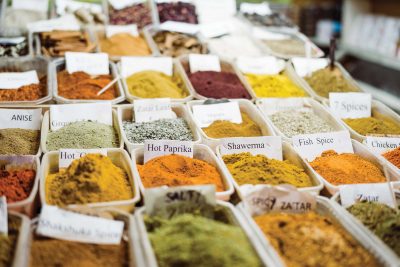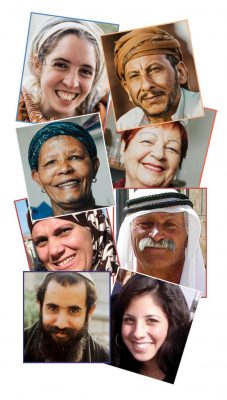×


We have detected your country as:
Please click here to go to the USA website or select another country from the dropdown list.
by: Kate Norman, BFP Staff Writer
Don’t let the term “Jewish state” fool you into thinking that Israel is a homogenous nation. After 2,000 years in exile, spread across the globe, the Jewish people have returned to their ancient homeland—bringing their Diaspora (outside Israel) cultures, languages, holidays and traditions with them.
This tiny country boasts a population of over 9.5 million people, according to Israel’s Central Bureau of Statistics (CBS). Of that population, 73.9% are Jewish, according to the Jewish Virtual Library; 21.1% are Arabs; and 5% are defined as “other”—non-Arab Christians, Samaritans, Baha’i, and others who identify as Jewish but are not considered so by the government’s definition of orthodox Jewish.
Of the total Arab population, 82.9% are Muslims, while 8% are Christians and 9% are Druze, according to the Israel Democracy Institute. In fact, of the total Christian population in Israel—which is 2%—some 76.7% are Arabs, while the Druze comprise 2% of Israel’s total population.
Israel is one of the most densely populated nations in the developed world, according to the World Population Review. And that densely packed population comprises a stunning variety of ethnicities. Just over 44% of Israel’s Jewish population are sabras—native Israeli by paternal origin, according to a 2015 CBS survey that breaks down Israel’s Jewish population by country of origin.
Since the modern State of Israel was reborn in 1948, over 3.3 million people from the corners of the earth have immigrated to the Land of Promise, the CBS reported.
Of the immigrants, over 26% came from Europe—mostly from Russia and the former Soviet Union (14%), but also from Romania (3.86%); Poland (3.59%); France (1.14%); 0.9% from Germany and Austria; 1.17% from Hungary, the Czech Republic and Slovakia; and less than 1% each from the UK, Bulgaria, Greece and other European countries.
Some 14% immigrated from Africa—mostly from Morocco (nearly 8%), with a small but significant population from Ethiopia (over 2%), among other African nations.
Over 10% originated from Asia: 3.6% from Iraq, 2.23% from Iran, 2.14% from Yemen, 1.19% from Turkey, and less than 1% from India and Pakistan as well as Syria and Lebanon.
The remaining nearly 5% came from the Americas and Oceania, with nearly 3% from the US, Canada, Australia and New Zealand. Another 1% came from Argentina and 0.76% from other Latin American countries.
All of these cultures mixing and blending together in the tiny nation have created a dazzling kaleidoscope of diversity within the Jewish state. Walking through the shuk (outdoor market) in Jerusalem or Tel Aviv, you will hear a stunning array of languages—Hebrew and Arabic, yes—but also English, Russian, Spanish, French and other languages you might not even recognize, such as the Amharic language spoken by many Ethiopian Jews.
And when these once-exiled Jews returned to their ancient homeland from all over the world, they brought with them more than different languages. They arrived with a vast array of culture: food, style of dress, music, traditions and holidays.
In Israel, there is almost always a holiday to celebrate: Jewish holidays, Christian, Druze and Muslim holidays—everything from Passover, Christmas and Ramadan to Nowruz, the Persian new year celebration.
Even the classic Israeli foods reflect the Jewish state’s cultural hodgepodge. One of the most popular dishes in Israel, schnitzel, was brought by Ashkenazi Jews (of European heritage), either from Germany or Austria.
Falafel, another classic dish in Israel, is a commonplace offering of ground and deep-fried chickpeas that originated somewhere in the Middle East, likely either in Egypt or the Levant. It made its way into the Jewish state and became Israel’s fast food.

Another common street food is shawarma, mouthwatering meat stacked in a cone shape, cooked on a rotisserie and sliced to serve. This dish originated in the Ottoman Empire, modern-day Turkey. But the spicy meat, like falafel, is found in many hole-in-the-wall restaurants and food stands in Israel, often served on pita or laffah flatbread.
Stop by a Russian market for a variety of meats and cheeses, or step into an Asian market for a small taste of sauces, seasonings and snacks from east Asia. Visit the Ishtabach restaurant in Jerusalem to taste a shamburak—a hearty, Syrian–Kurdish meat pie. Travel to Tel Aviv for sushi, tacos or just about any other cuisine your palate desires. Step into a colorful spice market and overwhelm your senses with za’atar, carob powder, saffron, sumac, Dead Sea salt—the list goes on. If you don’t know what to do with the spices, ask the shop owner. He can give you a family recipe as well as a colorful story about how his great-grandfather traveled to Israel from a far-off land.
And just as colorful as the spice markets of Israel, so are the people of Israel. Blonde-hair-blue-eyed, dark-skinned as the night sky, olive complexioned, freckled redheads and everything in between. It is a beautiful and stunning collection of humanity from worlds apart gathering in a small country, their common homeland—bringing their culture, languages, food and traditions with them. And the diverse variety of people and cultures mix, blend and coexist to form a beautiful kaleidoscope.

Photo Credit: Click on photo to see photo credit
All logos and trademarks in this site are property of their respective owner. All other materials are property of Bridges for Peace. Copyright © 2024.
Website Site Design by J-Town Internet Services Ltd. - Based in Jerusalem and Serving the World.